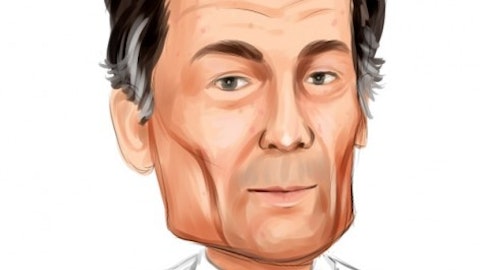But I can’t wait until 2026 to file an application, so that’s why we’re doing it now. We are being prepared, and if we are going to use it, we’ll use it. If it’s not necessary because a better offering comes out of DTCC with the efficiencies for the clients, we will stay with DTCC. That’s really where we stand on the relationship and the application, if that makes sense to you.
Brian Bedell: Yes, that’s a great answer. Thank you for that.
Lynne Fitzpatrick: Then Brian, you had just asked for this data point on the cash market–
Brian Bedell: EBS and brokerage, yes.
Lynne Fitzpatrick: The total trading revenue for the quarter was $69 million, similar to Q4, and the total revenue from cash markets, including data and some of the connectivity, was also consistent with Q4 at $92 million.
Brian Bedell: Great, okay. And between EBS and BrokerTec, similar to Q4?
Lynne Fitzpatrick: Yes, so if you break that out, BrokerTec was at $38 million, in line with Q4, and EBS was at $31 million. That’s just the trading.
Brian Bedell: Yes, thank you.
Terrence Duffy: Thanks Brian, appreciate it.
Operator: Thank you all. Our next question now is from Alex Blostein with Goldman Sachs. Ma’am, your line is open.
Alex Blostein: Hey everybody, good morning. A question on the energy markets for you guys again. Definitely good to see momentum in overall volumes picking up here in April and over the course of the first quarter, but it looks like the market share trends between you guy and ICE and WTI continue to kind move a little bit more towards ICE, or those share gains have been relatively sticky. You gave us a bit of an update, I think last quarter, on the underlying composition of the mix, kind of what’s been driving that, so hoping you could update that and give us a sense of whether or not you’re seeing any shift in the underlying producers, consumers, more kind of core user base there, and if CME is working on anything to claw some of the market share back. Thanks.
Terrence Duffy: Thanks Alex. Let me just touch on the first point, on the first quarter especially as it relates to energy and the market share. The market share did not shift from Q3 into–or Q4 into Q1, excuse me, as it relates to market share, so I’m–they’re not continuing to supposedly take market share. Again, the way we count market share is all of our different products that we have, including our Gulf Coast contracts that we did not maybe point out as clearly over the last several years, so I don’t see the market share that you’re referring to in Q1. As it relates to the other parts of your question, I’m going to ask Derek to answer them.
Derek Sammann: Yes, thanks. Appreciate the question, Alex. As Terry mentioned at the top of the call, the breadth and the scale and the diversity of the franchise here is, I think, yielding benefits for shareholders and certainly providing multiple ways that customers use us to manage risk. Energy delivered strong results in the first quarter this year, up 16%. When you look at the significant participant of where that business is growing, we saw the fastest growth in our buy side and commercial customers, and we saw record options level at the overall level as well. When you look at energy being a key contributor to our non-U.S. growth, our non-U.S. growth in energy was up 38% this year, as well as our record options volume up almost 60%.
That’s helping to drive a strong RPC of a little over $1.33 in the energy business. If you look at the core benchmark products, and I’ll come back to the point Terry just made, when you compare our WTI contracts to ICE’s WTI contracts, our market share in Q1 was flat in Q4, about 74%. When you look at our WTI options against ICE’s WTI options, we actually saw an increase in market share to 89% from 86%, so where we compete directly with ICE, we are either maintaining or growing that market share. But let me talk a little bit about what’s actually going on. When the U.S. is actually producing and exporting crude oil at record levels, follow that physical flow, and what does that mean? That means we have new and record amounts of non-U.S. customers that have exposure to U.S. crude and also Henry Hub to the same degree, so that’s an increasing set of customer participants that we have not seen before, which is why when you look at where the growth is happening in our WTI complex particularly, we’re seeing our non-U.S. WTI growth of up 30% and our commercial customers up 21%.
The very customers, whether it’s the buy side or the commercial customers, that are looking for that open interest and looking for the best exposure for the energy markets, are coming to see WTI to manage that risk. The other parts of the franchise that Terry talked about, our WTI franchise isn’t just our WTI futures and options, it’s our grades contracts which continues to grow. We actually just exceeded our open interest in our grades contracts exceeding 600,000 contracts – that’s up almost 50% year-on-year to a new record. Alex, that’s important because 80% of that open interest holding is with commercial customers, to have exposure to the global export market out of the U.S. and into Europe and Asia. When we think about that growth and the client segments and the regional growth, it’s reflective of the physical flows going out into the rest of the world.




